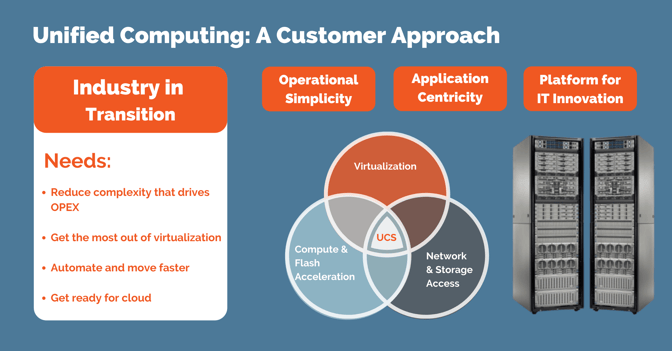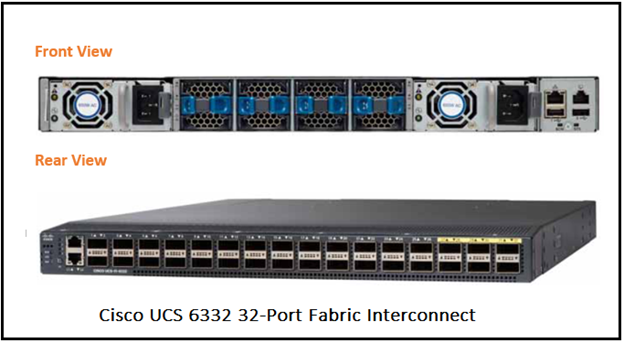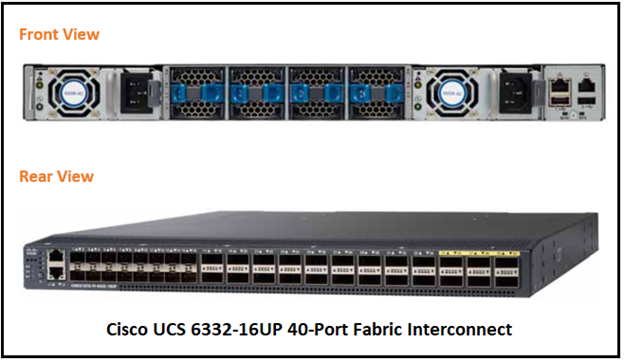All You Need to Know About the Cisco UCS 6332 Fabric Interconnect
-1.png)
The Unified Computing System (UCS) Fabric Interconnect (FI) is a core part of the design to improve scalability and reduce the total cost of ownership of data centers. Through integrating all components into a single platform, the system acts as a single unit which simplifies management. Cisco UCS Architecture provides a range of products including a UCS VIC (virtual interface card), UCS Blade Server Chassis, UCS FEX (Fabric Extenders), Blade Chassis FEX, Rack Mount FEX, B-Series Blade Servers, C-Series Rack Servers, and more. The fundamental difference Cisco UCS is the servers are connected to the Fabric Interconnects, then the FI is connected to the network switches. The devices are usually installed as head units at the top of server racks, in which all the server components are attached to the fabric interconnect. Today we'll dive into the UCS FI 6332 and how it can find its way to the top of rack in your data centers.
Download the guide and refer back to it at any time!
A Quick Look into the Fabric Interconnect
Each Fabric Interconnect is typically configured as a highly available clustered pair in production environments and provide active-active data traffic. By deploying in pairs, each server or blade chassis is connected to both Fabric Interconnects to protect against FI failure. Fabric Interconnects provide two capabilities:
- Network Connectivity to both LAN and SAN
- UCS infrastructure management through embedded management software UCSM for both hardware and software management
Cisco has introduced a new series of Fabric Interconnects, the 6300 series with Gen 3 UCS hardware. The framework incorporates a low-inertness, lossless a 10 and 40 Gigabit Ethernet bound together system texture with big business class, x86-engineering workers. The framework is an incorporated, versatile, multi skeleton stage in which all assets take an interest in a brought together administration space. The core functionality is the same in all generations, with a difference in number of physical ports, and can be upgraded to the latest UCSM software. Of these physical ports, the Fabric Interconnects are converged meaning the physical SFP and FI software configuration determines whether each port can be configured as an Ethernet port, an FCoE, or an FC port.

The UCS 6332 32-Port Fabric Interconnect
The Cisco UCS 6332 32-Port Fabric Interconnect is a 1RU Gigabit Ethernet, and FCoE switch providing up to 2.56 Tbps throughput and up to 32 ports. The switch has 32 fixed 40-Gbps Ethernet and FCoE ports.

- Ports 1—4 can operate as 40-Gbps QSFP+ ports, or as 4 x 10 Gbps SFP+ breakout ports, or can be optionally outfitted with Quad to SFP (QSA) adapters to provide 10 Gbps operation
- Ports 5—12 and 15—26 can operate as 40-Gbps QSFP+ ports, or as 4 x 10 Gbps SFP+ breakout ports, or can be optionally outfitted with Quad to SFP (QSA) adapters to provide 10 Gbps operation
- Ports 13 and 14 can operate as 40-Gbps QSFP+ ports. They cannot operate as 4 x 10 Gbps SFP+ breakout ports
- Ports 27—32 are dedicated 40 Gbps QSFP+ operation
Boost your network connectivity and management of your connected blades, chassis, and rack servers. To read the full datasheet, click here.
Hardware Options For You
It's important to compare firewalls from both Palo Alto and Fortinet. Here at PivIT, we know the importance doesn't stop with the device itself. It stretches to what is available today, financing options, and more. We make it easy for you to find the hardware to build your network on your terms.
Cisco UCS 6332-16UP 40-Port Fabric Interconnect
The Cisco UCS 6332-16UP 40-Port Fabric Interconnect is a 1RU 10-GbE, 40-GbE, and native Fibre Channel switch providing up to 2.43-Tbps full-duplex throughput.

- Ports 1—16 operate as SFP+ Universal Ports capable of operating at 1/10-Gbps fixed Ethernet or 4/8/16 Gbps Fibre Channel ports
- Ports 17—34 operate as 40 Gbps QSFP+ ports or as 18 4 x 10 Gbps SFP+ breakout ports or can be optionally outfitted with QSA adapters to provide 10 Gbps operation
- Ports 35—40 operate as fixed 40 Gbps QSFP+ ports
You can find the full datasheet for the 6332-16UP 40-Port here.
UCS 6332 Capabilities
The 6332-16UP Fabric Interconnect is the management and communication backbone for Cisco UCS B-Series Blade Servers, C-Series Rack Servers, and 5100 Series Blade Server Chassis.
- 24 40-Gigabit Ethernet and Fiber Channel over Ethernet
- 16 1- and 10-Gbps and FCoE or 4-,8-, and 16-Gbps Fiber Channel unified ports
- Increased bandwidth up to 2.43 Tbps
- Centralized unified management.
- Efficient cooling and serviceability both side of switches, redundant fans and power supplies, and rear cabling.
Performance
- Cisco UCS 6332:- Layer 2 hardware forwarding at 2.56 Tbps or 720 million packets per second
- Cisco UCS 6332-16UP:- Layer 2 hardware forwarding at 2.43 Tbps or 683 million packets per second
- MAC address table entries: 32,000
- Low-latency cut-through design
QoS
- Layer 2 IEEE 802.1p
- Eight hardware queues per port
- Per-port QoS configuration
- CoS trust
- Per-port virtual output queuing
- Egress strict-priority queuing and port-based scheduling
Why You Should Have the 6332 at the Top of Your Rack
The Cisco UCS Fabric Interconnect can boil down to one job, connecting your UCS Servers to your network. With each unique IP address, each Fabric Interconnect logs into the Cisco UCS Manager. When configuring, you can add variety to the ports, for example:
- Universal Ports - Operate as Ethernet or Fibre Channel ports
- Ethernet Ports - For Ethernet or FCoE connectivity
- Uplink Ports - for uplink to the Cisco Nexus Infrastructure
Cisco's UCS Manager allows all elements connected to the interconnects to participate in a single, highly available management domain. Through the unified fabric a lower total cost of ownership can be achieved by reducing the number of NICs, HBAs, switches, and cables required to operate the interconnect. Transparently, the unified fabric encapsulates Fiber Channel packets into Ethernet. The Fabric Extender architecture scales to 20 blade chassis without adding complexity by eliminating the need for dedicated chassis management and blade switch. By ultimately reducing the number of cables needed, management simplifies and the architecture provides deterministic latency for optimized application performance. Take a look at Cisco UCS Architecture here.
| UCS 6332 Provides | What You Get at the Top of Your Rack |
| Lossless Fabric |
|
| Priority Flow Control |
|
| System-wide Bandwidth Management |
|
| Cisco Data Center VM-FEX technology |
|
| Redundant Hot-Swappable Fans & Power Supplies |
|
| Front-to-Back Cooling |
|
| SFP+ Ports |
|
| SFP Compatible Ports |
|
About PivIT Global
Here at PivIT Global we want to help you find the right infrastructure to best set your business up for success. We have a team ready to answer any questions or to chat more on the 6332 Fabric Interconnect to suit your needs! Need to get in touch quicker than a phone call? No worries, leave a quick comment below.
